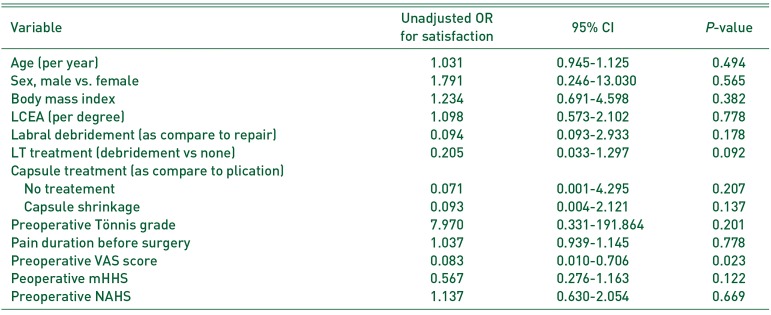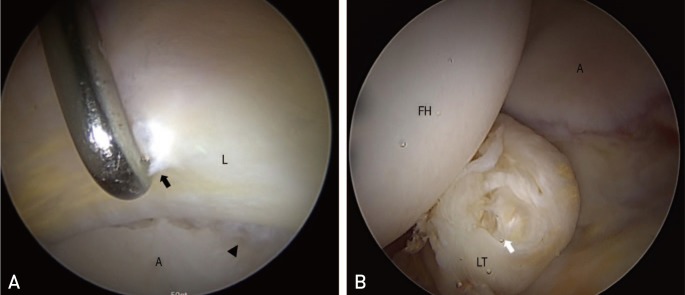1. Jo S, Lee SH, Wang SI, Smith B, O'Donnell J. The role of arthroscopy in the dysplastic hip-a systematic review of the intra-articular findings, and the outcomes utilizing hip arthroscopic surgery. J Hip Preserv Surg. 2016; 3:171–180. PMID:
27583155.

2. Yeung M, Kowalczuk M, Simunovic N, Ayeni OR. Hip arthroscopy in the setting of hip dysplasia: a systematic review. Bone Joint Res. 2016; 5:225–231. PMID:
27313136.
3. Murphy SB, Ganz R, Müller ME. The prognosis in untreated dysplasia of the hip. A study of radiographic factors that predict the outcome. J Bone Joint Surg Am. 1995; 77:985–989. PMID:
7608241.

4. Nunley RM, Prather H, Hunt D, Schoenecker PL, Clohisy JC. Clinical presentation of symptomatic acetabular dysplasia in skeletally mature patients. J Bone Joint Surg Am. 2011; 93(Suppl 2):17–21. PMID:
21543683.

5. Tönnis D. Normal values of the hip joint for the evaluation of X-rays in children and adults. Clin Orthop Relat Res. 1976; (119):39–47.
6. Byrd JW, Jones KS. Hip arthroscopy in the presence of dysplasia. Arthroscopy. 2003; 19:1055–1060. PMID:
14673446.

7. Christensen CP, Althausen PL, Mittleman MA, Lee JA, McCarthy JC. The nonarthritic hip score: reliable and validated. Clin Orthop Relat Res. 2003; (406):75–83. PMID:
12579003.

8. Dawes P, Haslock I. Visual analogue scales. Ann Rheum Dis. 1982; 41:434–435. PMID:
7114926.

9. Henak CR, Abraham CL, Anderson AE, et al. Patient-specific analysis of cartilage and labrum mechanics in human hips with acetabular dysplasia. Osteoarthritis Cartilage. 2014; 22:210–217. PMID:
24269633.

10. Vafaeian B, Zonoobi D, Mabee M, et al. Finite element analysis of mechanical behavior of human dysplastic hip joints: a systematic review. Osteoarthritis Cartilage. 2017; 25:438–447. PMID:
27836678.

11. Henak CR, Ellis BJ, Harris MD, Anderson AE, Peters CL, Weiss JA. Role of the acetabular labrum in load support across the hip joint. J Biomech. 2011; 44:2201–2206. PMID:
21757198.

12. Lievense AM, Bierma-Zeinstra SM, Verhagen AP, Verhaar JA, Koes BW. Influence of hip dysplasia on the development of osteoarthritis of the hip. Ann Rheum Dis. 2004; 63:621–626. PMID:
15140766.
13. Irie T, Takahashi D, Asano T, et al. Is there an association between borderline-to-mild dysplasia and hip osteoarthritis? Analysis of CT osteoabsorptiometry. Clin Orthop Relat Res. 2018; 476:1455–1465. PMID:
29698301.

14. Ding Z, Sun Y, Liu S, Chen J. Hip arthroscopic surgery in borderline developmental dysplastic hips: a systematic review. Am J Sports Med. Published online November 27, 2018. DOI:
10.1177/0363546518803367.

15. Edelson R, Burks RT, Bloebaum RD. Short-term effects of knee washout for osteoarthritis. Am J Sports Med. 1995; 23:345–349. PMID:
7661265.
16. Lee YK, Ha YC, Hwang DS, Koo KH. Learning curve of basic hip arthroscopy technique: CUSUM analysis. Knee Surg Sports Traumatol Arthrosc. 2013; 21:1940–1944. PMID:
23073816.

17. Mehta N, Chamberlin P, Marx RG, et al. Defining the learning curve for hip arthroscopy: a threshold analysis of the volume-outcomes relationship. Am J Sports Med. 2018; 46:1284–1293. PMID:
29337602.

18. Schüttler KF, Schramm R, El-Zayat BF, Schofer MD, Efe T, Heyse TJ. The effect of surgeon's learning curve: complications and outcome after hip arthroscopy. Arch Orthop Trauma Surg. 2018; 138:1415–1421. PMID:
29802454.

19. Matosin N, Frank E, Engel M, Lum JS, Newell KA. Negativity towards negative results: a discussion of the disconnect between scientific worth and scientific culture. Dis Model Mech. 2014; 7:171–173. PMID:
24713271.

20. Fanelli D. Do pressures to publish increase scientists' bias? An empirical support from US States Data. PLoS One. 2010; 5:e10271. PMID:
20422014.

21. Kalore NV, Jiranek WA. Save the torn labrum in hips with borderline acetabular coverage. Clin Orthop Relat Res. 2012; 470:3406–3413. PMID:
22810161.

22. Parvizi J, Bican O, Bender B, et al. Arthroscopy for labral tears in patients with developmental dysplasia of the hip: a cautionary note. J Arthroplasty. 2009; 24(6 Suppl):110–113.

23. Chandrasekaran S, Darwish N, Martin TJ, Suarez-Ahedo C, Lodhia P, Domb BG. Arthroscopic capsular plication and labral seal restoration in borderline hip dysplasia: 2-year clinical outcomes in 55 cases. Arthroscopy. 2017; 33:1332–1340. PMID:
28408155.

24. Domb BG, Chaharbakhshi EO, Perets I, Yuen LC, Walsh JP, Ashberg L. Hip arthroscopic surgery with labral preservation and capsular plication in patients with borderline hip dysplasia: minimum 5-year patient-reported outcomes. Am J Sports Med. 2018; 46:305–313. PMID:
29268026.

25. Domb BG, Stake CE, Lindner D, El-Bitar Y, Jackson TJ. Arthroscopic capsular plication and labral preservation in borderline hip dysplasia: two-year clinical outcomes of a surgical approach to a challenging problem. Am J Sports Med. 2013; 41:2591–2598. PMID:
23956133.
26. Jo S, Hooke AW, An KN, Trousdale RT, Sierra RJ. Contribution of the ligamentum teres to hip stability in the presence of an intact capsule: a cadaveric study. Arthroscopy. 2018; 34:1480–1487. PMID:
29397288.

27. Fukui K, Briggs KK, Trindade CA, Philippon MJ. Outcomes after labral repair in patients with femoroacetabular impingement and borderline dysplasia. Arthroscopy. 2015; 31:2371–2379. PMID:
26315056.

28. Hatakeyama A, Utsunomiya H, Nishikino S, et al. Predictors of poor clinical outcome after arthroscopic labral preservation, capsular plication, and cam osteoplasty in the setting of borderline hip dysplasia. Am J Sports Med. 2018; 46:135–143. PMID:
28992426.

29. Maldonado DR, Perets I, Mu BH, et al. Arthroscopic capsular plication in patients with labral tears and borderline dysplasia of the hip: analysis of risk factors for failure. Am J Sports Med. 2018; 46:3446–3453. PMID:
30419179.









 PDF
PDF ePub
ePub Citation
Citation Print
Print




 XML Download
XML Download